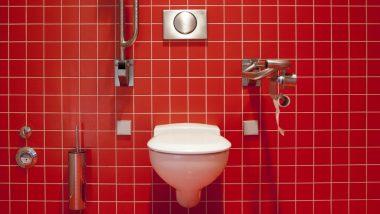New Delhi, April 21: Respiratory droplets are the most prominent source of transmission for Covid-19. However, flushing a toilet can generate large quantities of microbe-containing aerosols depending on the design, water pressure or flushing power of the toilet at public restrooms, an Indian-origin researchers-led study has warned.
Public restrooms are especially cause for concern for transmitting Covid-19 because they are relatively confined, experience heavy foot traffic and may not have adequate ventilation. According to researchers, a variety of pathogens are usually found in stagnant water as well as in urine, faeces and vomit.
"After about three hours of tests involving more than 100 flushes, we found a substantial increase in the measured aerosol levels in the ambient environment with the total number of droplets generated in each flushing test ranging up to the tens of thousands," said Siddhartha Verma, co-author and an Assistant Professor in Florida Atlantic University's Department of Ocean and Mechanical Engineering in the US. Triple Mutation Coronavirus Variant Detected In India As Second COVID-19 Wave Batters The Country.
The droplets were detected at heights of up to 5 feet for 20 seconds or longer after initiating the flush. Researchers detected a smaller number of droplets in the air when the toilet was flushed with a closed lid, although not by much, suggesting that aerosolised droplets escaped through small gaps between the cover and the seat.
"Both the toilet and urinal generated large quantities of droplets smaller than 3 micrometers in size, posing a significant transmission risk if they contain infectious microorganisms. Due to their small size, these droplets can remain suspended for a long time," Verma said.
When dispersed widely through aerosolisation, these pathogens can cause Ebola, norovirus that results in violent food poisoning, as well as Covid-19 caused by SARS-CoV-2, according to a team of scientists from Florida Atlantic University's College of Engineering.
The team once again put physics of fluids to the test to investigate droplets generated from flushing a toilet and a urinal in a public restroom under normal ventilation conditions.
To measure the droplets, they used a particle counter placed at various heights of the toilet and urinal to capture the size and number of droplets generated upon flushing.
Results of the study, published in the journal Physics of Fluids, demonstrate how public restrooms could serve as hotbeds for airborne disease transmission, especially if they do not have adequate ventilation or if toilets do not have a lid or cover. Most public restrooms often are not equipped with toilet seat lids and urinals are not covered. Double Mask Means Double Protection Like the N95 Mask? From Benefits to Dos and Don'ts, Expert Reveals How to Cover Your Face to Protect Yourself Amid COVID-19 Pandemic.
There was a 69.5 per cent increase in measured levels for particles sized 0.3 to 0.5 micrometres, a 209 per cent increase for particles sized 0.5 to 1 micrometres, and a 50 per cent increase for particles sized 1 to 3 micrometres.
"The study suggests that incorporation of adequate ventilation in the design and operation of public spaces would help prevent aerosol accumulation in high occupancy areas such as public restrooms," said Manhar Dhanak, chair of FAU's Department of Ocean and Mechanical Engineering, and professor and director of SeaTech.
(The above story first appeared on LatestLY on Apr 21, 2021 09:10 PM IST. For more news and updates on politics, world, sports, entertainment and lifestyle, log on to our website latestly.com).













 Quickly
Quickly


